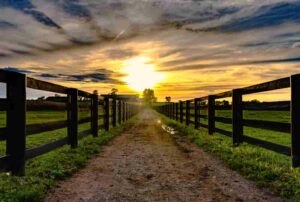Farm Fencing Grants: Types and Benefits (Get it Today)
To ensure the safety and security of the farm livestock, enclose the agricultural property with boundaries, and protect the crops, you may require the farm fencing grants to install the fences without any hindrances.
The agricultural fencing market is projected to grow from 2023 to 2030 with an annual growth rate (CAGR) of 4.6%, which says approximately $2.40 Billion in volume size in the commercial field; the farm fencing grants can accommodate the funds required for the farmers to protect their farming lands.
Farm Fencing Grants For Farmers 2024
Agricultural and commercial fencing can cost between $2 to $20 per linear foot. Many farmers in the United States cannot afford to have such expensive safeguarding solutions and seek farm fencing grants.

Government entities, non-profit organizations, and agricultural supporting agencies may offer farm fencing grants for farmers 2024 to promote livestock safety, sustainable agriculture, and habitat conservation.
Farm fencing is the most significant and fundamental aspect considered in farm management. It has its own practical as well as aesthetic benefits. You can get to learn about it in this article.
The following advantages of farm fencing would align your understanding with the thought process of seeking the funds to do your farm management with certainty and land productivity.
- Animal Containment
- Predators Protection
- Crop Protection
- Property Demarcation
- Safety and Security
- Controlled Grazing
- Aesthetic Value
- Increased Farm Worth
- Disease Control
- Weed Manager
- Pest Manager
- Traffic Control
- Sensitive Area Saving
- Privacy to inhabitants
- Flexible Farming
- Environment Protection
The first and foremost reason to install the fencing is to protect the livestock (domesticated animals) by containing them within your farm’s boundary and preventing them from moving away on the roads, nearby areas, or neighboring the other farming properties.
By preventing the wild animals from entering the farm, the fencing protects the crops and works as safety guards. The Farm Fencing Grants For Farmers 2023 program gets released every year, and many agriculture households can get the benefits and ease their financial burden.
See More: Get Cyber Security Grants for Education
Farm Grants For Fencing
To maintain agricultural success and farming sustainability, the right kind of planning, installation, and maintenance is required that can significantly impact the quality. Government agencies mainly provide farm grants for fencing.
Get the benefits from the nearby available farm grants for fencing. You can contact the administrative panel or seek the online application form from the authorized organization.
The following list of farm grants for fencing might help you get sufficient funds to secure your farms. You must reach out to the given organization, know the policy for the available programs and check eligibility criteria to fit into their funding supplies.
Government Agricultural Department
- Every country has government agricultural departments that can provide Farm Fencing Grants and other offerings, such as construction and infrastructure facilities and funding, education, houses, shelter, etc.
- U.S. Natural Resources Conservation Service (NRCS)
- The NRCS can provide sufficient funding and financial support to promote sustainable grazing and protect water resources to contribute to the state’s economic development.
- Environmental Quality Incentives Program (EQIP)
- The above-given NRCS offers this EUIP to provide farmers with economic support and the required technological assistance and equipment to implement their farming habits. The grant value is between $0.50 to $4.00 per foot for the land conversation practices #382.
- Conservation Stewardship Program (CSP)
- This program under the NRCS is working towards agriculture and farming development. It supplies the farm fencing grants to manage their land conversation and ensure safety and security.
- Conservation Reserve Program (CRP)
- It falls under the control of the Farm Fencing Agencies of the United States, which support the farmers who are working hard to convert farming lands into conservation grounds. The grant value is between $0.10 to $0.20 per foot for the land conversation practices #649.
- Wildlife Habitat Incentives Program (WHIP)
- The program has been merged with the EQIP, but it has not lost its relevancy, and you can gain the same benefits under the given program to gain the fence grants.
- U.S. Natural Resources Conservation Service (NRCS)
See More: Grants For Starting a Campground
Benefits of Farm Fencing
The state or regional government most often regulates the provided grants for fencing, and you may get the associated benefits as well for participating in such programs dedicated to the welfare of the people.
The following benefits of farm fencing would help you understand why safeguarding your farms can influence the productivity of your agricultural land.
- Livestock Containment and Protection
- This program is specifically designed for the containment and protection of livestock and to secure these domesticated animals. It also provides fencing grants, mainly to protect the outside neighboring places, traffic, or natural habitats from the threat imposed by such livestock.
- Organic or Specialty Farming
- Many regions support farming methods that benefit based on the land location. They provide farm fencing grants to promote farming habits, such as cross-contamination from GMO Crops.
- Soil Conservation
- This can be a significant aspect of any agricultural facility where you can conserve the land’s soil to promote the prevention of soil erosion.
- Pest and Disease Management
- Under pet and disease management and control, farm grants for fencing can be available for the eligible lands and crops the farmers operate. It is designed to prevent the spread of the disease related to the animal and husbandry.
- Historic Farm Preservation
- In the regions where traditional farming practices still prevail and require the preservation of historical land properties and agriculture values, federal funding might be available to procure and safeguard the historic land.
Agricultural Innovation also helps bring new technology uses and applications in farming practices and having a different approach in installing the fencing facilities around the farmland territory.
See More: Free Government Grants For Dental Implants
SARE Grants and Types
The Sustainable Agriculture Research and Education (SARE) program falls under the National Institute of Food and Agriculture, a U.S. Department of Agriculture branch. The SARE provides financial assistance to advanced farming methods, including fencing grants for farmers 2023.

The SARE operates in the United States in four regions, including North Central, Northeast, South, and West, while each area functions independently. For every grant cycle, they release the calls for proposals as a part of their application process.
Before the deadlines, you can participate in the calls for proposals to apply for farm grants for fencing. There’s also a review process available to monitor the eligibility of the applicants. Once your SARE grant is approved, you’ll typically be bound to provide regular progress reports. The following types of SARE Grants are available for the benefit of the farmers.
- Research and Education Grants
- Farmer and Rancher Grants
- Professional Development Grants
- Partnership Grants
- Graduate Student Grants
- Youth Educator Grants
See More: Housing Grants For Disabled Veterans With PTSD
USDA Fencing Grants
For more than 100 years, the United States Department of Agriculture has been safeguarding equality for the democratic people of America. The fencing programs offered by the USDA can be widely distributed with different specifications and policies.

The following programs may assist you with the USDA fencing grants, and you can further advocate the provided scheme or policies by visiting their sites.
- Agricultural Conservation Easement Program (ACEP)
- Fencing falls under the associated agriculture practices; hence, the ACEP is the kind of program supplied by the USDA to ensure farmer assistance and conserve agricultural land and wetlands. The following two components are the primary functions of this program.
- Agricultural Land Easements (ALE)
- Wetland Reserve Easements (WRE)
- The productivity of farming practices can be increased with fencing g facilities, according to the conversation in an interview conducted the previous year on farming practices and Innovation in America.
- ALE helps prevent adequate agricultural land from converting into non-farming land. The grants for fencing can be provided on eligible grounds, including privately owned cropland, rangeland, pastureland, grassland, and non-industrial forest land.
- The landowners or farmers must agree to maintain a certain level of restrictions on the land use to keep the land’s up-to-date agricultural properties.
- Fencing falls under the associated agriculture practices; hence, the ACEP is the kind of program supplied by the USDA to ensure farmer assistance and conserve agricultural land and wetlands. The following two components are the primary functions of this program.
- USDA Farm Service Agencies
- Although it does not explicitly provide grants or free funding, it can deliver a handsome amount in low-interest loans to cover the cost of fencing and other land infrastructure or reconstruction work in the agricultural domain.
- Farmers can easily afford the interest rate the farm loan program provides with easy installments or repayment cost structure, which can be an alternative to the fencing grants for farmers 2023.
- The farm service agency (FSA) falls under the USDA and provides the following types of loans to eligible farmers that might be used as grants for fencing to procure agricultural land.
- Direct Farm Ownership Loans
- Direct Farm Operating Loans
- Guaranteed Farm Loans
- Emergency Farm Loans
- Youth Loans
- Beginning Farmers and Ranchers Loans
- Beginning Farmer and Rancher Development Program (BFRDP)
- This program helps to invite newcomers into farming practices with innovative approaches, provides guidance and education related to agriculture, and spreads farming awareness.
- Often this program offers valuable resources to enhance the quality and productivity of adequate working land, including farm fencing grants.
- The BFRDP aims to deliver fundamental farming education to newly arrived or became farmers and ranchers, along with knowledge transfer, resources, and networking to the agricultural industry.
See More: 14 Federal Grants For Real Estate
Conclusion
In this article, we have comprehensively discussed the farm fencing grants available for farmers to ensure the safety and security of the livestock, neighboring crops, and other outside animals entering their farm territory. We have also covered the USDA fencing grants that might ease your financial burden and help you manage the expenses to maintain the overall quality of the farming land.
FAQs
What is farm fencing?
Farm fencing is the method to cover the farmland boundary by installing the fencing in sequence over the edges to secure and protect the livestock and crop of the healthy agricultural land.
Which fencing is best for farm?
It depends upon the particular requirement; vinyl and aluminum fences are widely used since they need minor maintenance and offer equal features compared to wooden fences.
What is the strongest type of fencing?
Wrought iron fences are considered the most vital type due to their durability and effective marking lines. It is also popular due to its aesthetic standout quality, creating a beautiful outline.
What is the cost of fencing of a farm?
Generally, wooden fencing costs between $5 to $20 per linear foot, whereas vinyl fencing is more costly, around $15 to $25; there are other low-cost fencing available in the market as well, such as barbed or woven wired fences, and smooth or meshed wires fences.



